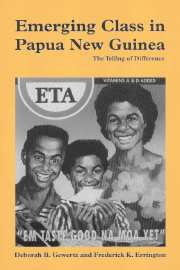Book contents
- Frontmatter
- Contents
- List of illustrations
- Acknowledgments
- Introduction: the twists and turns of difference
- 1 The middle class the (new) Melanesian way
- 2 How the grass roots became the poor
- 3 The realization of class exclusions
- 4 The hidden injuries of class
- 5 The problem(s) of the poor
- 6 Class and the definition of reasonability
- Conclusion: on dark nights of the soul
- Notes
- References
- Index
6 - Class and the definition of reasonability
Published online by Cambridge University Press: 03 December 2009
- Frontmatter
- Contents
- List of illustrations
- Acknowledgments
- Introduction: the twists and turns of difference
- 1 The middle class the (new) Melanesian way
- 2 How the grass roots became the poor
- 3 The realization of class exclusions
- 4 The hidden injuries of class
- 5 The problem(s) of the poor
- 6 Class and the definition of reasonability
- Conclusion: on dark nights of the soul
- Notes
- References
- Index
Summary
The case of the “compo girl”
As we have been showing throughout this book, members of the affluent middle class – bureaucrats, professionals, politicians and businesspeople – had become committed to changing the nature of distinction. Consistent with achieving the “homes, gardens and schools” referred to by Father Dambui in the last chapter, they were promulgating a reclassification of identities and interests: they were reclassifying people as to their worth and their prospects. Thus, the words they used to describe crime and class said, in effect, that certain Papua New Guineans (the poorly socialized of the urban grass roots) were no longer able to make socially appropriate – reasonable – choices.
In this chapter we continue to examine the changing nature and basis of “reasonability.” We do so to learn how middle-class Papua New Guineans have been increasingly able to associate themselves with – reasonable – middle-class people wherever they might be and to dissociate themselves from many of their fellow – unreasonable – countrymen. (Such a dissociation was, of course, necessary if Papua New Guinean golfers were to snap their fingers at Papua New Guinean caddies, to return to an earlier example.) Our concentration is, therefore, in this final ethnographic chapter somewhat broader than in the others. Here we move beyond Wewak to understand how class distinctions have come in a nearly absolute sense to separate some who were living modern, relatively individualistic, lives from many who were living more traditional, more collectively oriented, lives. In the case we examine, matters of gender, especially as they related to the self-determination of women as modern individuals with constitutional rights, came to facilitate this separation.
The gendered story of class distinction we tell focuses on the “compo girl,” whose (genuine) travails first became widely known on 3 May 1996.
- Type
- Chapter
- Information
- Emerging Class in Papua New GuineaThe Telling of Difference, pp. 120 - 140Publisher: Cambridge University PressPrint publication year: 1999



